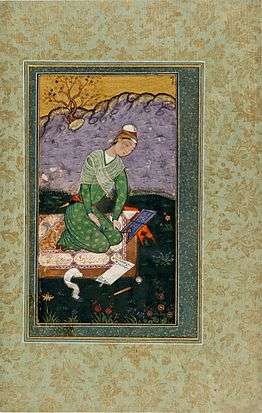Quran reading
| Quran |
|---|
 |
|
Quran reading is the reading (tarteel, tajwid, or taghbir) aloud, reciting, or chanting of portions of the Quran. The reciter is called a tālī, murattil, mujawwid, or most commonly a qari.[1] Recitation should be done according to rules of pronunciation, intonation, and caesuras established by the Islamic prophet Muhammad, though first recorded in the eighth century CE. The most popular reading is that of Hafs on the authority of `asim. Similarly, each melodic passage centers on a single tone level, but the melodic contour and melodic passages are largely shaped by the reading rules, creating passages of different lengths whose temporal expansion is defined through caesuras. Skilled readers may read professionally for mosques in cities.
The Qur'an is marked with twenty-six symbols, circles, rectangles, dashes and letters, some in color. These are written above, below, or beside the letters of the alphabet. They indicate the pronunciation of consonants, whether the blending of neighboring or adjacent consonants is allowed, and where recitation pauses and caesuras are forbidden and possible.[2] In this last respect their function is analogous to that of Biblical cantillation marks, but unlike these they do not constitute a word-for-word notation of musical motifs.
Ways of recitation

There are 7 Mutawatir (a transmission which has independent chains of authorities so wide as to rule out the possibility of any error and on which there is consensus) ways of reading (or Qira'at) and 3 Mashhur (these are slightly less wide in their transmission, but still so wide as to make error highly unlikely) as listed below:
- Mutawatir
- Nafi‘ al-Madani (d. 169/785)
- Ibn Kathir al-Makki (d. 120/737)
- Abu 'Amr ibn al-'Ala' (d. 154/770)
- Ibn Amir ad-Dimashqi (d. 154/736)
- Aasim ibn Abi al-Najud (d. 127/745)
- Hamzah az-Zaiyyat (d. 156/772)
- Al-Kisa'i (d. 189/804)
- Mashhur
- Abu Ja'far (d. 130/747)
- Ya'qub (d. 205/820)
- Khalaf (d. 229/844)
However, the most common is Hafs on the authority of 'Asim, which have been used all over the world of Islam.[3]
See also
- Bible study (Christian), private or small group reading predominantly in Protestant Christianity
- Khutbah
- Pani patti
- Saad El Ghamidi
- Sermon, in Christianity
- Torah reading and cantillation in Judaism
Notes
Reading of the Quran may be with or without proper understanding. Despite the fact proper pronunciation is essential for reading the Quran an understanding the text is also appreciated and encouraged in many ways. Motivation for reading and knowing the meaning is related with interest which again shape readers engagement in the society. [4]
- ↑ Touma 1996, p. 153-154
- ↑ Touma 1996, p. 155
- ↑ Bewley, Aishah. "The Seven Qira'at of the Qur'an", Aisha Bewley's Islamic Home Page
- ↑ https://www.academia.edu/11796656/THE_ROLE_OF_READING_MOTIVATION_AND_INTEREST_IN_READING_ENGAGEMENT_OF_QURANIC_EXEGESIS_READERS
References
- Habib Hassan Touma (1996). The Music of the Arabs, trans. Laurie Schwartz. Portland, Oregon: Amadeus Press. ISBN 0-931340-88-8.
Further reading
- Gade, Anna M. Perfection Makes Practice: Learning, Emotion, and the Recited Qur’ân in Indonesia. Honolulu: University of Hawaii Press, 2004.